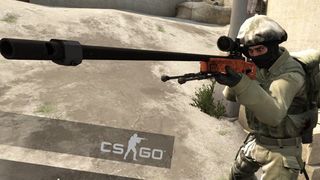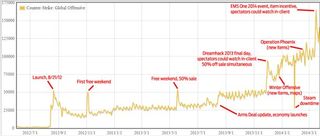Valve explains how CS:GO became the second most-played game on Steam

One of three talks Valve delivered at the Game Developers Conference last week was “Building the Content that Drives the Counter-Strike: Global Offensive Economy,” a session by Technical Artist Bronwen Grimes. Grimes' presentation mainly focused on how Valve developed its method for mostly-automating the creation of new weapon skins that roll out regularly in updates like Operation Phoenix and Winter Offensive .
Late into the talk, though, Grimes brought up data from Steam Graph as a way of measuring the impact of CS:GO's content updates on its it's popularity, which is high enough lately to make it the second most-played game on Steam. I've duplicated Grimes' graph here with some additional annotations of my own.

As the graph indicates, free CS:GO weekends doubled the game's peak concurrent users in November 2012 and May 2013. The launch of an item economy through the Arms Race update in August 2013 had a significant . As Grimes put it during her talk: “After our economy launched, we had a pretty dramatic increase in peak player numbers, bringing us to regular highs that we'd only achieved previously by making the game temporarily free.”
Tournaments, though, have produced the most substantial upticks in concurrent users, presumably due to the fact that CS:GO allows players to watch competitive matches in the game client in real-time. “This last spike here is Dreamhack. It's a big tournament for CS:GO with a high viewership,” said Grimes at GDC. “Our game was also on sale during this time period and that caused a huge player spike, nearly doubling our player count. There was a large influx of new players at this time, and they stuck around at a really high rate. In fact they stuck around at a much higher rate than players from previous sales. And so we can see that not only are our player numbers up, but our player retention is up.”
The recent EMS One Katowice tourney seemed to skyrocket CS:GO's peak concurrent users by 50 or 60,000. Without access to numbers for Battlefield 4 and other games, we're left to assume that CS:GO's 2.2 million monthly unique players are enough to make it the most popular multiplayer shooter on PC.
PC Gamer Newsletter
Sign up to get the best content of the week, and great gaming deals, as picked by the editors.

Evan's a hardcore FPS enthusiast who joined PC Gamer in 2008. After an era spent publishing reviews, news, and cover features, he now oversees editorial operations for PC Gamer worldwide, including setting policy, training, and editing stories written by the wider team. His most-played FPSes are CS:GO, Team Fortress 2, Team Fortress Classic, Rainbow Six Siege, and Arma 2. His first multiplayer FPS was Quake 2, played on serial LAN in his uncle's basement, the ideal conditions for instilling a lifelong fondness for fragging. Evan also leads production of the PC Gaming Show, the annual E3 showcase event dedicated to PC gaming.
Most Popular





